
Wilkinson. Essential Neurology 2005
.pdf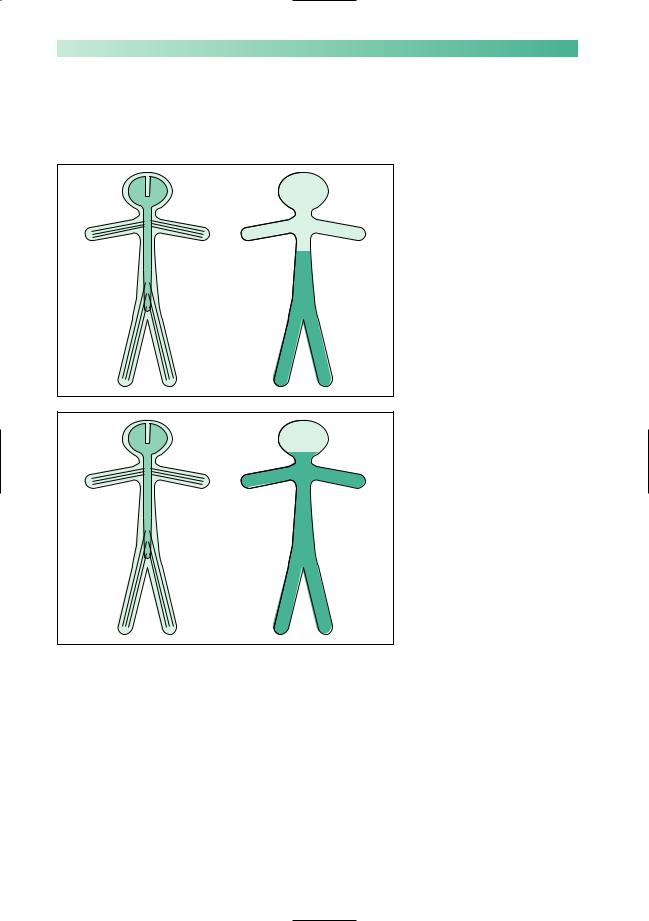
10 |
CHAPTER 1 |
A spinal cord lesion more usually causes upper motor neurone signs in both legs, often asymmetrically since the pathology rarely affects both sides of the spinal cord equally.
X
Paraparesis, if the lesion is at or below the cervical portion of the spinal cord.
X
Tetraparesis or quadriparesis, if the lesion is in the upper cervical cord or brainstem.
Lesions anywhere between the midbrain and lower spinal cord may, in addition, involve ascending sensory pathways and fibre tracts involving sphincter function. There may therefore be sensory loss below the level of the lesion, and the possibility of bladder, bowel and sexual symptoms.
There may be physical signs which indicate the level of the lesion very accurately:
•LMN signs, loss of reflexes, dermatome pain or sensory loss, at the level of the lesion in the spinal cord;
•cerebellar signs or cranial nerve palsies when the lesion is in the midbrain, pons or medulla.
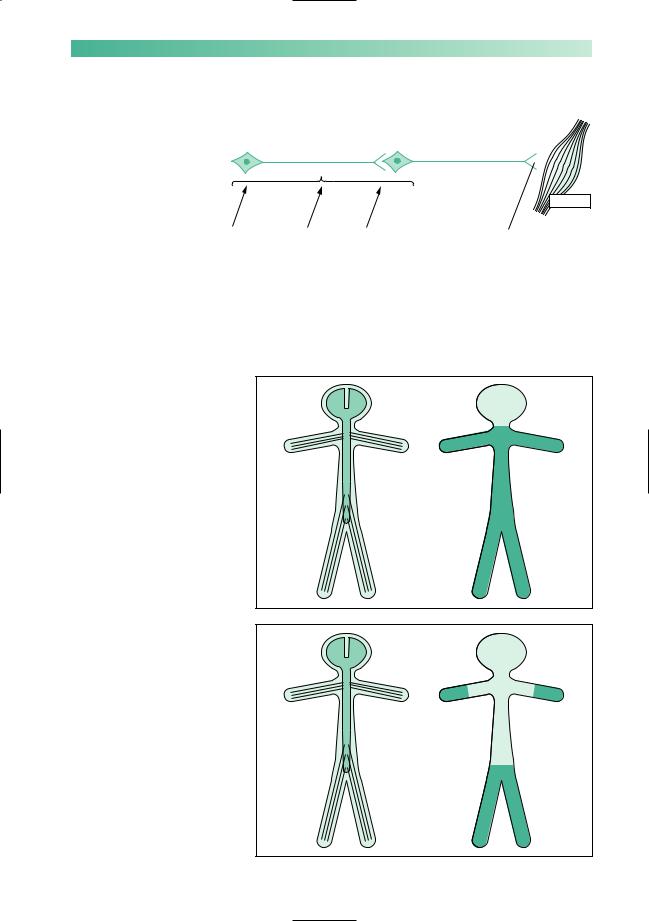
CLINICAL SKILLS |
11 |
Lower motor neurone
Upper motor neurone |
Lower motor neurone |
|
X |
Muscle
Basal ganglia Cerebellum Sensation |
Neuromuscular junction |
Characteristics of lower motor neurone lesions:
•wasting;
•fasciculation;
•decreased tone (i.e. flaccidity);
•weakness;
•decreased or absent reflexes;
•flexor or absent plantar responses.
Generalized LMN weakness may result from pathology affecting the LMNs throughout the spinal cord and brainstem, as in motor neurone disease or poliomyelitis. Generalized limb weakness (proximal and distal), trunk and bulbar weakness characterize this sort of LMN disorder.
X X
X
X X X
Generalized LMN weakness may also result from widespread damage to the axons of the LMNs. This is the nature of peripheral neuropathy (also called polyneuropathy). The axons of the dorsal root sensory neurones are usually simultaneously involved. The LMN weakness and sensory loss tend to be most marked distally in the limbs.
X X X X X X X X
X X
X |
X |
X |
X |
X |
X |
X |
X |
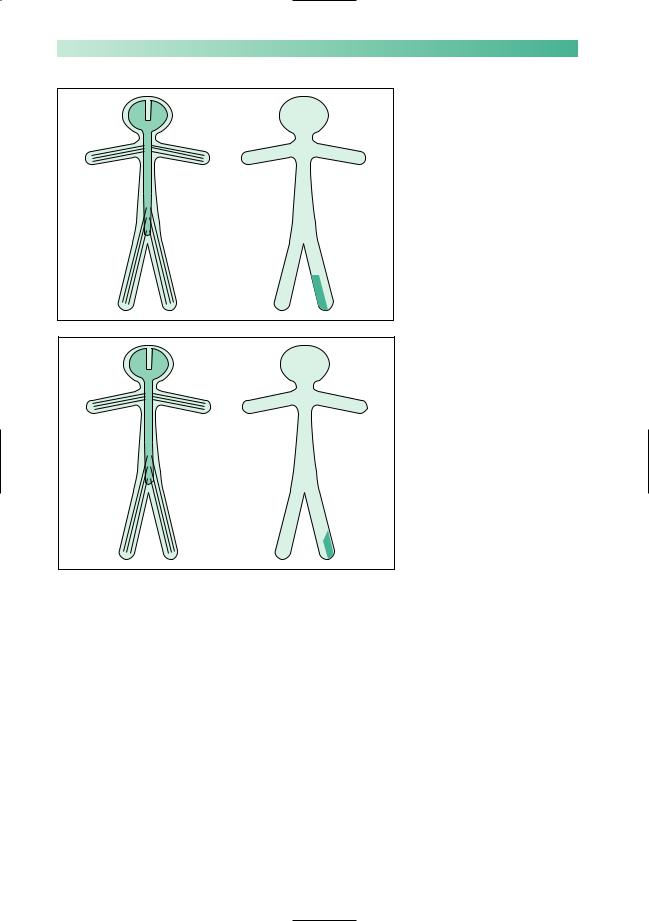
12
X
X
CHAPTER 1
LMN weakness may be confined to the distribution of one spinal root (above) or one individual peripheral nerve (below). In such circumstances, the LMN signs are found only in the muscles supplied by the particular nerve root or peripheral nerve in question. Almost always there is sensory impairment in the area supplied by the nerve or nerve root. Examples of such lesions are an S1 nerve root syndrome caused by a prolapsed intervertebral disc, or a common peroneal nerve palsy caused by pressure in the region of the neck of the fibula.
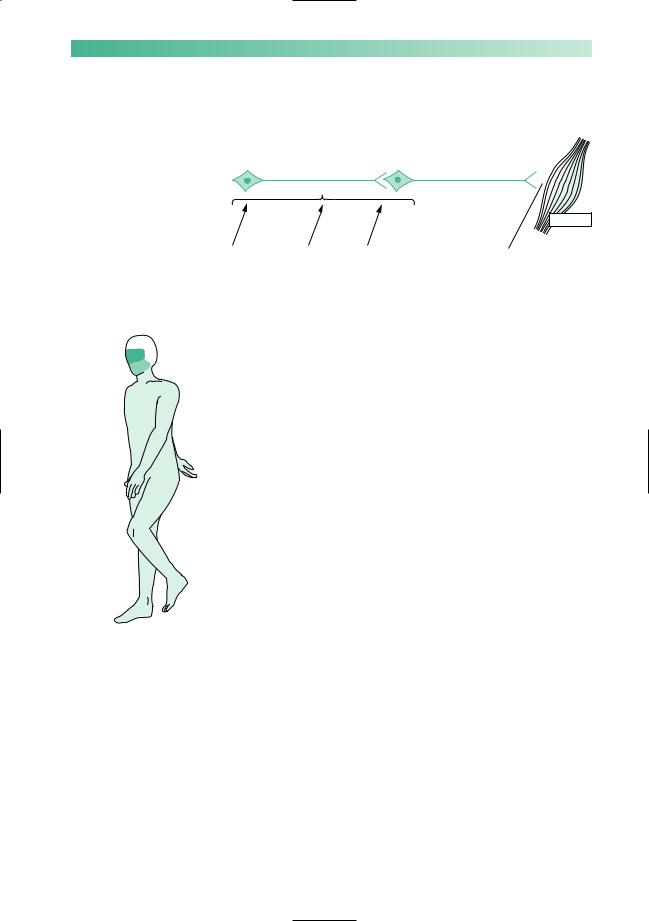
CLINICAL SKILLS |
13 |
Neuromuscular junction
Upper motor neurone |
Lower motor neurone X |
Muscle
Basal ganglia Cerebellum Sensation |
Neuromuscular junction |
The classic disease of the neuromuscular junction is myasthenia gravis. Characteristics of myasthenia gravis:
•uncommon;
•no wasting;
•tone normal;
•weakness;
•fatiguability;
•reflexes normal;
•positive response to anticholinesterase.
The pattern of muscle involvement in this rare disease:
• ocular muscles common: ptosis;
diplopia;
•bulbar muscles fairly common: dysarthria;
dysphagia;
•trunk and limb muscles less common: limb weakness;
trunk weakness; breathing problems.
More common paralysis due to neuromuscular blockade is that which is produced by anaesthetists during operative surgery.
Myasthenia gravis would not be a likely diagnosis in a patient presenting with left leg malfunction.
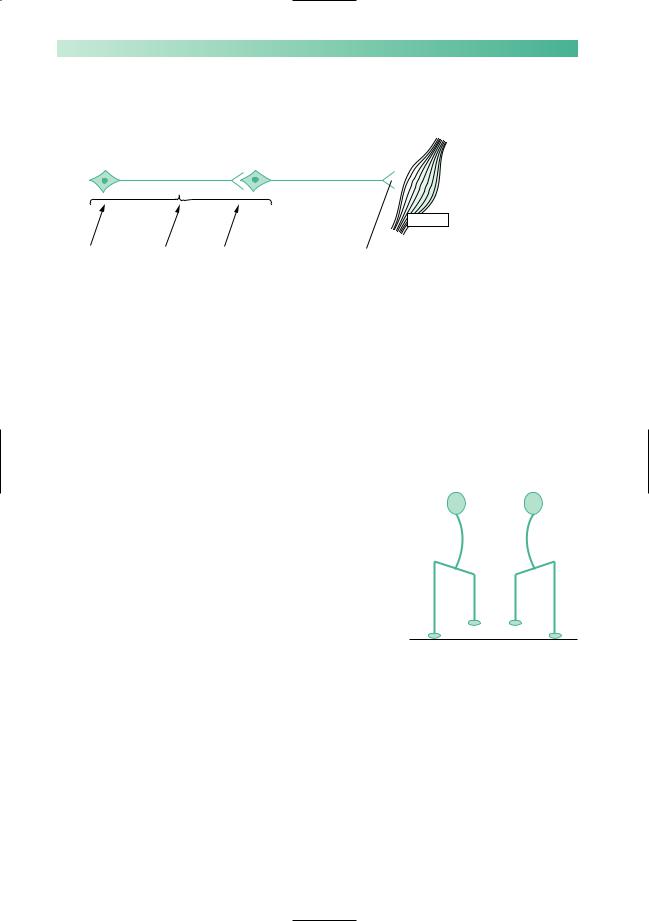
14
Muscle
Upper motor neurone |
Lower motor neurone |
X
Muscle
Basal ganglia Cerebellum Sensation |
Neuromuscular junction |
Characteristics of primary muscle disease:
•uncommon;
•wasting;
•no fasciculation;
•weakness;
•tone normal or reduced;
•reflexes normal or reduced.
Proximal muscle weakness typifies most primary muscle disease. The patient has difficulty in lifting his arms above shoulder level, and in rising from a chair into the standing position. He needs to use his arms to help him do this. In the standing position, the trunk muscle weakness often allows an abnormal amount of extension of the lumbar spine, so that the abdomen protrudes forwards. When walking, the abdominal and pelvic muscle weakness allow downward tilting of the pelvis when the leg is off the ground. This is known as Trendelenburg weakness.
A diagnosis of muscle disease would be unlikely in a patient presenting with unilateral leg malfunction. This is partly because muscle disease is rare, and partly because it usually produces bilateral symmetrical weakness.
CHAPTER 1
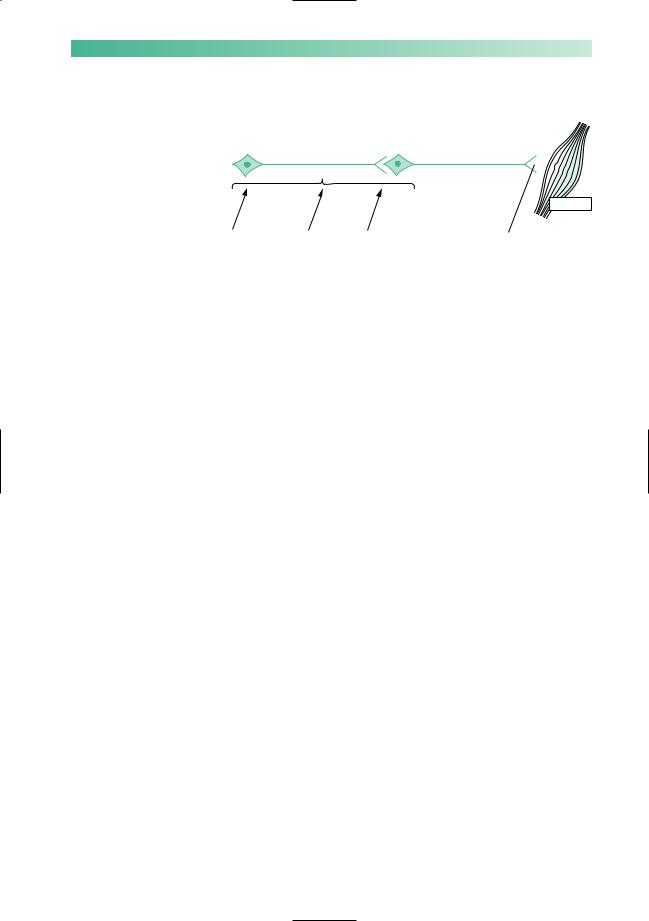
CLINICAL SKILLS |
15 |
Basal ganglia
Upper motor neurone |
Lower motor neurone |
X |
Muscle |
|
|
Basal ganglia Cerebellum Sensation |
Neuromuscular junction |
Two main syndromes, each with different characteristics:
1.Parkinson’s disease:
•common;
•tremor at rest;
•increased tone;
•bradykinesia;
•flexed posture.
2.Involuntary movements:
•uncommon;
•involuntary movements at rest and during action;
•tone increased, normal or reduced;
•normal speed of movement;
•all sorts of postural abnormalities.
No weakness in either.
These syndromes may be unilateral and are commonly asymmetrical, the pathology being in the basal ganglia of the contralateral cerebral hemisphere.
It is not at all improbable that a patient complaining of left leg malfunction, and difficulty in walking, might be presenting with Parkinson’s disease.
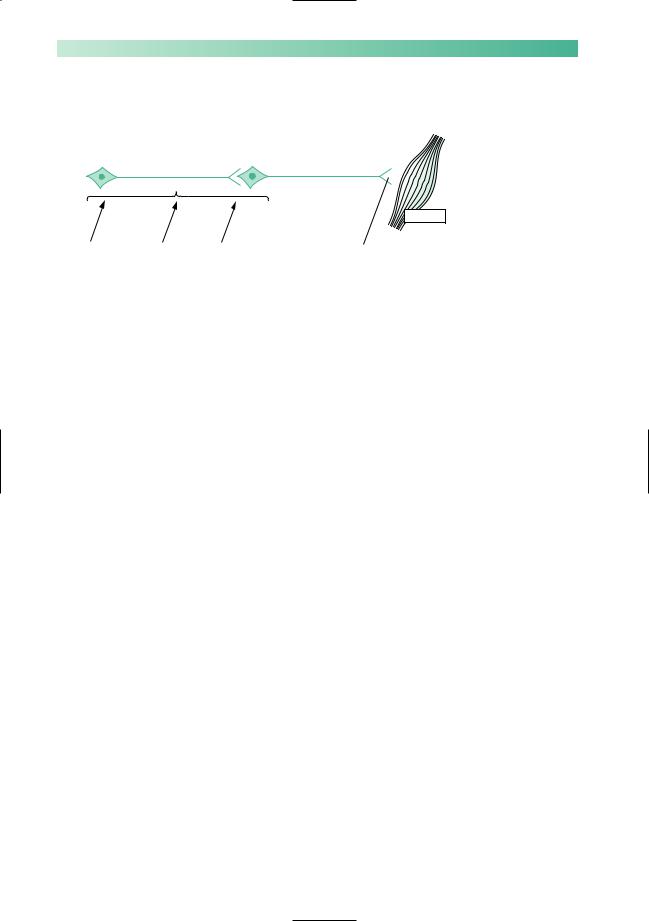
16
Cerebellum
Upper motor neurone |
Lower motor neurone |
Muscle
X
Basal ganglia Cerebellum Sensation |
Neuromuscular junction |
Characteristics of cerebellar lesions are:
1.Incoordination of muscle activity:
•in the head: nystagmus, dysarthria;
•in the arms: finger–nose ataxia, kinetic tremor, difficulty with rapid alternating movements (dysdiadochokinesia);
•in the legs: heel–knee–shin ataxia, gait ataxia, falls.
2.There is no weakness. (Alcohol in large doses impairs cerebellar function. Intoxicated people show all the features of muscular incoordination mentioned above, but may be very strong.)
3.In a unilateral cerebellar lesion, the neurological deficit is ipsilateral to the side of the lesion. A patient complaining of malfunction of the left leg due to a left cerebellar lesion would have heel–knee–shin ataxia most marked in the left leg, and gait ataxia with deviation to the left. There might also be left arm cerebellar signs, and nystagmus most marked looking to the left.
CHAPTER 1
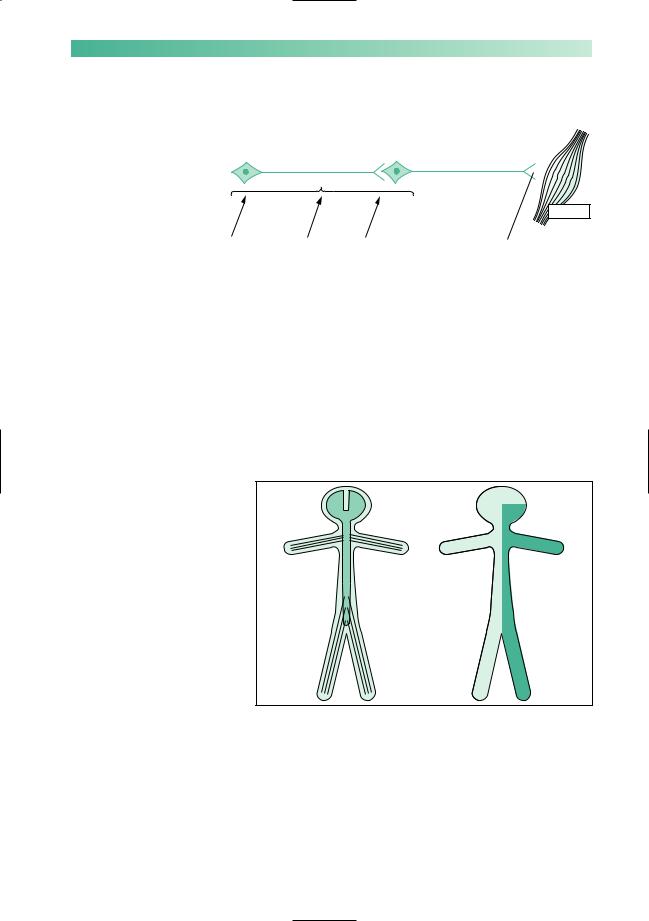
CLINICAL SKILLS |
17 |
Sensation
Upper motor neurone |
Lower motor neurone |
X |
Muscle |
|
|
Basal ganglia Cerebellum Sensation |
Neuromuscular junction |
Characteristics of movement in the presence of sensory loss:
•ataxia or clumsiness of movement due to loss of sense of position mainly, but also due to loss of touch sensation;
•partial compensation by active monitoring of movement by the eyes;
•no weakness.
There are three main clinical syndromes where sensory loss may play an important role in impairing movement and function.
X
Cerebral hemisphere lesions: impaired accurate movements of the contralateral limbs because central registration of limb position is lost.
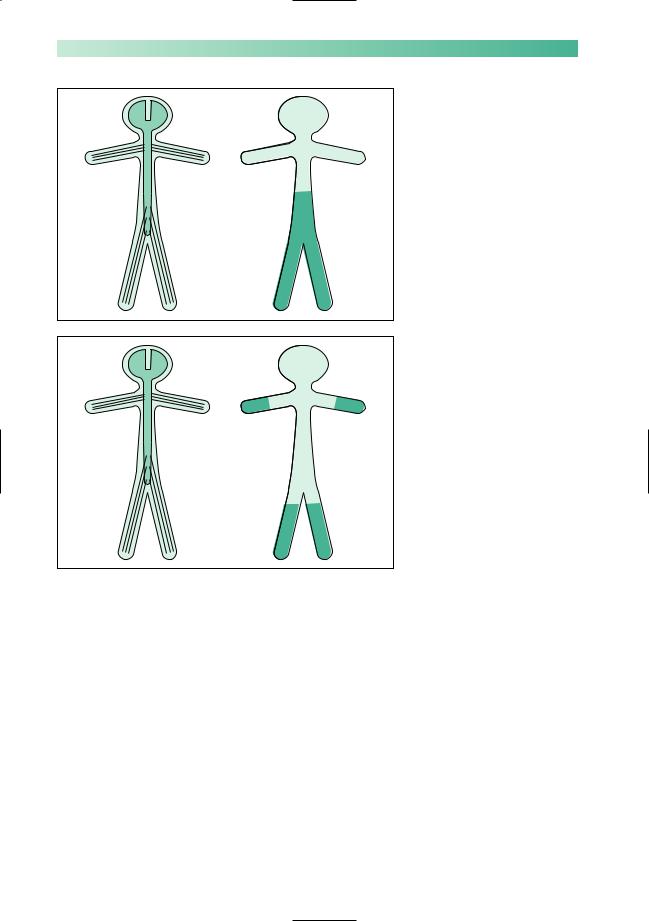
18
X
X X X X X X
X X
X |
X |
X |
X |
X |
X |
X |
X |
CHAPTER 1
Loss of proprioceptive sense in the legs and feet may occur as a result of either spinal cord disease (above) or peripheral neuropathy (below). The loss of sense of position gives rise to clumsiness of leg movement when walking, unsteadiness, and the need to watch the feet and floor carefully. There is marked unsteadiness and falling when vision cannot compensate, e.g. in the dark, in the shower, when washing the face, when putting clothes over the head. Romberg’s sign (stance steady with eyes open, but unsteady with eyes closed) is positive in such patients.
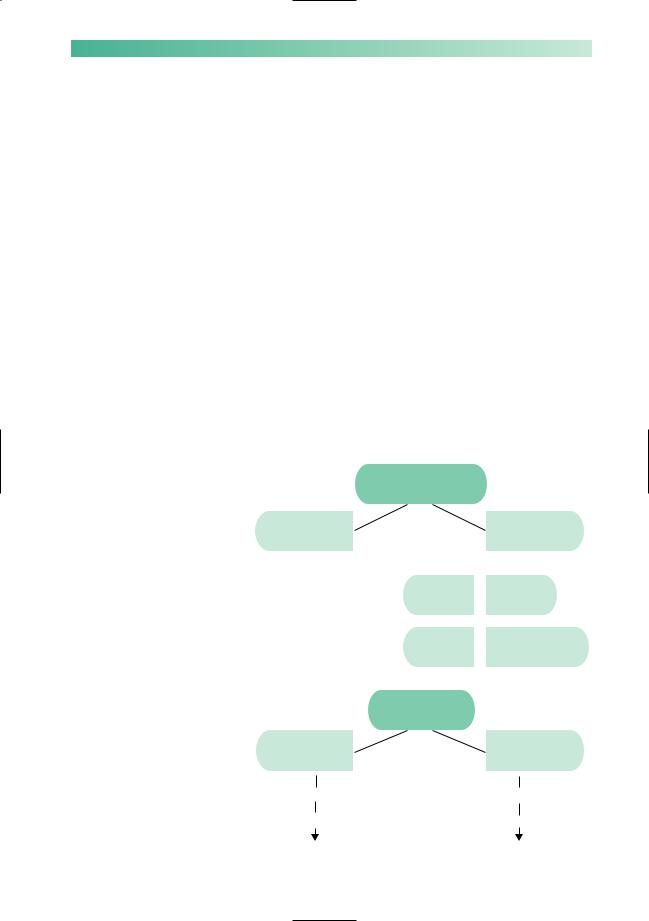
CLINICAL SKILLS |
19 |
The patient’s response to his symptoms
Hopefully the nature of the patient’s physical illness causing the left leg malfunction will emerge from the history and examination, carried out against this background knowledge of common patterns of neurological failure. Just as important, and to be conducted during the same history and examination, is an evaluation of the patient’s response to the illness. How much is the imperfect function in the left leg bothering him? What are the practical consequences of having the problem in his everyday life? What does he think is the matter? Has he worried about a really serious cause? Is he anticipating recovery or further disability?
In this section we recognize that the total illness in any patient is the sum of the physical illness plus the patient’s psychological reaction to the physical illness. The latter may be appropriate and entirely understandable. Sometimes, however, the reaction is exaggerated for some reason, making the whole illness a bigger one for the patient, his family and the medical staff looking after him. Recognition of the two elements of illness, and the management of both, are particularly appropriate in patients with neurological disorders.
Patient's total illness
Physical
Patient's
illness
psychological reaction
A physical illness with an appropriate reaction
The same physical illness with an exaggerated reaction, producing a bigger total illness
|
Total |
|
illness |
Physical |
Patient's |
illness |
reaction |
|
Both elements need to be: |
Diagnosed |
Recognized |
Investigated |
Understood |
Treated |
Discussed |
